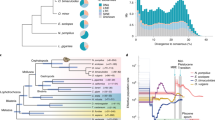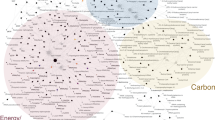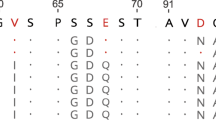Abstract
Mammals that degrade uric acid are not affected by gout or urate kidney stones. It is not fully understood how they convert uric acid into the much more soluble allantoin. Until recently, it had long been thought that urate oxidase was the only enzyme responsible for this conversion1,2. However, detailed studies of the mechanism and regiochemistry of urate oxidation3,4,5 have called this assumption into question, suggesting the existence of other distinct enzymatic activities. Through phylogenetic genome comparison, we identify here two genes that share with urate oxidase a common history of loss or gain events. We show that the two proteins encoded by mouse genes catalyze two consecutive steps following urate oxidation to 5-hydroxyisourate (HIU): hydrolysis of HIU to give 2-oxo-4-hydroxy-4-carboxy-5-ureidoimidazoline (OHCU) and decarboxylation of OHCU to give S-(+)-allantoin. Urate oxidation produces racemic allantoin on a time scale of hours, whereas the full enzymatic complement produces dextrorotatory allantoin on a time scale of seconds. The use of these enzymes in association with urate oxidase could improve the therapy of hyperuricemia.
This is a preview of subscription content, access via your institution
Access options
Subscribe to this journal
Receive 12 print issues and online access
$259.00 per year
only $21.58 per issue
Buy this article
- Purchase on Springer Link
- Instant access to full article PDF
Prices may be subject to local taxes which are calculated during checkout



Similar content being viewed by others
References
Vogels, G.D. & Van der Drift, C. Degradation of purines and pyrimidines by microorganisms. Bacteriol. Rev. 40, 403–468 (1976).
Stryer, L. Biochemistry (W.H. Freeman, New York, 1995).
Modric, N., Derome, A.E., Ashcroft, S.J.H. & Poje, M. Tracing and identification of uricase reaction intermediates. A direct 13C-NMR/isotope-labelling evidence. Tetrahedr. Lett. 33, 6691–6694 (1992).
Kahn, K., Serfozo, P. & Tipton, P.A. Identification of the true product of the urate oxidase reaction. J. Am. Chem. Soc. 274, 5435–5442 (1997).
Kahn, K. & Tipton, P.A. Spectroscopic characterization of intermediates in the urate oxidase reaction. Biochemistry 37, 11651–11659 (1998).
Oda, M., Satta, Y., Takenaka, O. & Takahata, N. Loss of urate oxidase activity in hominoids and its evolutionary implications. Mol. Biol. Evol. 19, 640–653 (2002).
Sarma, A.D., Serfozo, P., Kahn, K. & Tipton, P.A. Identification and purification of hydroxyisourate hydrolase, a novel ureide-metabolizing enzyme. J. Biol. Chem. 274, 33863–33865 (1999).
Mulrooney, S.B. & Hausinger, R.P. Metal ion dependence of recombinant Escherichia coli allantoinase. J. Bacteriol. 185, 126–134 (2003).
Snel, B., Bork, P. & Huynen, M.A. The identification of functional modules from the genomic association of genes. Proc. Natl. Acad. Sci. USA 99, 5890–5895 (2002).
Hurst, L.D., Pal, C. & Lercher, M.J. The evolutionary dynamics of eukaryotic gene order. Nat. Rev. Genet. 5, 299–310 (2004).
Marcotte, E.M. et al. Detecting protein function and protein-protein interactions from genome sequences. Science 285, 751–753 (1999).
Pellegrini, M., Marcotte, E.M., Thompson, M.J., Eisenberg, D. & Yeates, T.O. Assigning protein functions by comparative genome analysis: protein phylogenetic profiles. Proc. Natl. Acad. Sci. USA 96, 4285–4288 (1999).
von Mering, C. et al. STRING: known and predicted protein-protein associations, integrated and transferred across organisms. Nucleic Acids Res. 33, D433–D437 (2005).
Tatusov, R.L., Koonin, E.V. & Lipman, D.J. A genomic perspective on protein families. Science 278, 631–637 (1997).
Barker, D. & Pagel, M. Predicting functional gene links from phylogenetic-statistical analyses of whole genomes. PLoS Comput. Biol. 1, e3 (2005).
Schultz, A.C., Nygaard, P. & Saxild, H.H. Functional analysis of 14 genes that constitute the purine catabolic pathway in Bacillus subtilis and evidence for a novel regulon controlled by the PucR transcription activator. J. Bacteriol. 183, 3293–3302 (2001).
Eneqvist, T., Lundberg, E., Nilsson, L., Abagyan, R. & Sauer-Eriksson, A.E. The transthyretin-related protein family. Eur. J. Biochem. 270, 518–532 (2003).
Lee, Y. et al. Transthyretin-related proteins function to facilitate the hydrolysis of 5-hydroxyisourate, the end product of the uricase reaction. FEBS Lett. 579, 4769–4774 (2005).
's-Gravenmade, E.J., Vogels, G.D. & van Pelt, C. Preparation, properties and absolute configuration of (−)-allantoin. Recl. Trav. Chim. Pays Bas 88, 929–939 (1969).
Santos, C.X., Anjos, E.I. & Augusto, O. Uric acid oxidation by peroxynitrite: multiple reactions, free radical formation, and amplification of lipid oxidation. Arch. Biochem. Biophys. 372, 285–294 (1999).
Pitts, O.M. & Priest, D.G. Uricase reaction intermediate. Mechanism of borate and hydroxide ion catalysis. Biochemistry 12, 1358–1363 (1973).
Bongaerts, G.P. & Vogels, G.D. Mechanism of uricase action. Biochim. Biophys. Acta 567, 295–308 (1979).
Swinkels, B.W., Gould, S.J., Bodnar, A.G., Rachubinski, R.A. & Subramani, S. A novel, cleavable peroxisomal targeting signal at the amino-terminus of the rat 3-ketoacyl-CoA thiolase. EMBO J. 10, 3255–3262 (1991).
Hayashi, S., Fujiwara, S. & Noguchi, T. Evolution of urate-degrading enzymes in animal peroxisomes. Cell Biochem. Biophys. 32, 123–129 (2000).
Gould, S.G., Keller, G.A. & Subramani, S. Identification of a peroxisomal targeting signal at the carboxy terminus of firefly luciferase. J. Cell Biol. 105, 2923–2931 (1987).
Hall, A.P., Barry, P.E., Dawber, T.R. & McNamara, P.M. Epidemiology of gout and hyperuricemia. A long-term population study. Am. J. Med. 42, 27–37 (1967).
Bomalaski, J.S. & Clark, M.A. Serum uric acid-lowering therapies: where are we heading in management of hyperuricemia and the potential role of uricase. Curr. Rheumatol. Rep. 6, 240–247 (2004).
Bowers, P.M. et al. Prolinks: a database of protein functional linkages derived from coevolution. Genome Biol. 5, R35 (2004).
Gouet, P., Courcelle, E., Stuart, D.I. & Metoz, F. ESPript: analysis of multiple sequence alignments in PostScript. Bioinformatics 15, 305–308 (1999).
Zanotti, G., D'Acunto, M.R., Malpeli, G., Folli, C. & Berni, R. Crystal structure of the transthyretin–retinoic-acid complex. Eur. J. Biochem. 234, 563–569 (1995).
Acknowledgements
We thank D. Acquotti and L. Ronda for technical help, A. Peracchi, A. Merli and G.L. Rossi for discussions and the Centre “G. Casnati” in Parma for providing instrumentation. This study has been partly supported by COFIN2003 and FilRP05.
Author information
Authors and Affiliations
Corresponding author
Ethics declarations
Competing interests
The authors declare no competing financial interests.
Supplementary information
Supplementary Fig. 1
13C NMR of the conversion of [15N, 13C]urate catalysed by UO, HIU hydrolase and OHCU decarboxylase. (PDF 322 kb)
Supplementary Table 1
Predicted functional association of urate oxidase (COG3648). (PDF 11 kb)
Rights and permissions
About this article
Cite this article
Ramazzina, I., Folli, C., Secchi, A. et al. Completing the uric acid degradation pathway through phylogenetic comparison of whole genomes. Nat Chem Biol 2, 144–148 (2006). https://doi.org/10.1038/nchembio768
Received:
Accepted:
Published:
Issue Date:
DOI: https://doi.org/10.1038/nchembio768
This article is cited by
-
Targeting Efficient Features of Urate Oxidase to Increase Its Solubility
Applied Biochemistry and Biotechnology (2024)
-
Generation of High Concentration Free Volatile Fatty Acids from Continuous Anaerobic Digestion of Chicken Manure by Suppressing the Decomposition of Nitrogenous Components
Molecular Biotechnology (2023)
-
The effects of free Cys residues on the structure, activity, and tetrameric stability of mammalian uricase
Applied Microbiology and Biotechnology (2023)
-
Regulation of aging by balancing mitochondrial function and antioxidant levels
The Journal of Physiological Sciences (2022)
-
Discovery of an ene-reductase for initiating flavone and flavonol catabolism in gut bacteria
Nature Communications (2021)



